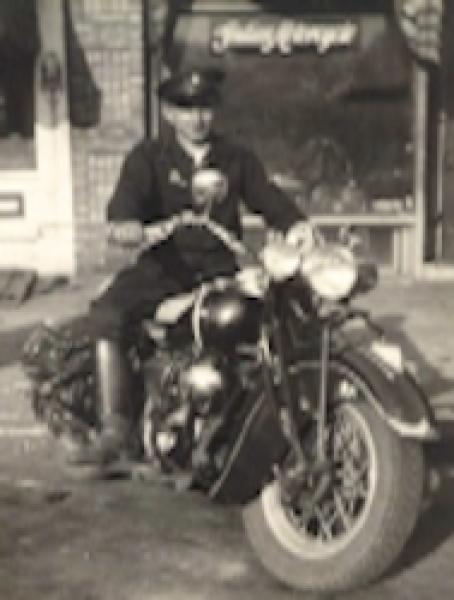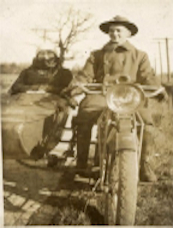
Milton Long on his 1940 Indian Chief
By Milton Long
Wooster, Ohio was no different than any other small city in 1941. People were getting over the depression and were able to buy cars and motorcycles.
Coming from a motorcycle family, it wasn’t unusual that I purchased my first motorcycle in 1937 at the age of 14. It was a 1935 sidecar job that I paid $125.00 for. It was a big improvement over the motor scooter I had owned before.
1941 was the start of my senior year at Wooster High School and I had purchased a 1940 Indian Chief from a fellow that had been called to active duty with the Ohio National Guard. It was supposed to be for one year, but due to Pearl Harbor they didn’t get out until 1945.

Since I had to work to pay for my motorcycle, I had a job at Wooster Rubber from 4 till 12 every day and this left only weekends to play around. The motorcycle gang tried to drive as many days as possible during the winter. December 7th, 1941, found us on a trip to Canton, Ohio, to visit the motorcycle shop that was only open on Sundays. They always had coffee and donuts for the riders that would brave the cold weather to visit their shop.
It was on the trip home that we stopped in Doylestown to eat. On the radio we learned of the attack on Pearl Harbor. It was a very sober bunch that finished out trio to Wooster. We all knew that this would mean war and that things would change very fast.
Monday at the High School found radios in every class room. We listened to President Roosevelt tell Congress that we were at war. Some went down and enlisted in the military. One thing was certain. We wouldn’t have to worry about getting a job after graduation. My folks made it plain that I had to graduate prior to going into the Service. My Dad was a WWI veteran, and he told me that he felt the first ones going into the military would be the ones that would be at risk of getting killed.
My senior paper was Army Life as a Career. I did not select this title due to any patriotic reason. It was that the material was easy to come by due to the Service Recruiters wanting to sign up the youth.
The people were starting to get on a war footing which would last until 1945. Service flags were going up in windows with a blue star indicating a family member was in the service. As the lists were published of the ones that were killed in action, the blue stars were replaced with gold stars, indicating they had lost someone in the war.
The paper would have pictures of the men that had been drafted and were leaving for the service. People spent a lot of time listening to the radio for news about the war. The theaters were showing news reels of the battles that were taking place.
People that had never worked for anyone in their lives went into the war plants and, for the first time, this included women. The churches became the focal point of the families and they provided nurseries to care for the children of Defense Plant workers. They also had special services for the military families to attend.
At the local Harley shop I met John Harley, the grandson of the founder of Harley-Davidson Motorcycles. He was on his last tour prior to going to Fort Knox to head up their motorcycle school. He convinced me to enlist in the Armored Forces so I could teach soldiers how to ride bikes in the Army. I enlisted in June of 1942 after graduation, and was to enter the Service in October.
During the summer of 1942, I completed my Eagle Scout requirements, at my Dads request. But I wasn’t around in December for the Eagle Boar of review. I did get my award in 1997 at the same time my grandson received his Eagle.
A lot of changes were taking place in Wooster. You saw a lot of men in uniform on their last trip home prior to shipping overseas. For some, it would be their last trip home. Period.
Rationing was in its early stages and, already, a small black market had started. The people with a German or Japanese background were treated as spies. Their stores were looted and many had to move away. Some Italians were treated the same way, and the wounds that resulted would take a long time healing.
During the summer of 1942 I saw my High School classmates and members of the motorcycle gang leaving for the Service. By the time that October came around, I was ready to go. My Dad was proud that I was going to serve, but my Mother thought that I should wait to be drafted.
I went to Cleveland on October 3rd to report. One of my buddies drove me to Cleveland. He was 4F due to heart problems. He ended up driving a Nitro truck From Texas to Akron the entire war.
At the old Post Office building, they gave us our physical. I knew you had to weigh 120 pounds to get in the Army, and I knew I only weighed 118. They had the scales set at 120 pounds, and when they stepped on the scales it would go plunk and that was it. I stepped on the scales and I could see the thing wasn’t going to go plunk. The man put his hand on my shoulder and pushed down. It went plunk and I was in the Army.
They marched us to the terminal tower where we would get a train for Fort Hayes, Columbus, Ohio. On the way to the station, an old lady grabbed my arm. She was crying and kept saying, You poor boy and If you only knew what you were getting into. Later I was to learn what she meant.
At 19 years of age I was about to embark on a major change in my life. One that would see me going overseas during the war. And to witness death and destruction that I would never forget. I would go from being a boy scout to learning how to kill or be killed.
I would not trade my experience in the military for anything in the world, but there is a lot I would like to forget. The toughest thing I had to experience upon returning home in 1946 was to look in the eyes of a mother whose son didn’t return, and try to reason why I returned and he didn’t. It was a guilty feeling, deep down, that I will never forget. I feel the veterans have a duty to tell their story so that future generations will know the truth about the war. We owe this to our buddies that didn’t make it back. And to those that may be called on in the future to serve this great country.
Ltc. Milton J. Long, Aus (Ret)
Published in U S Legacies Magazine May 2005
- Log in to post comments
